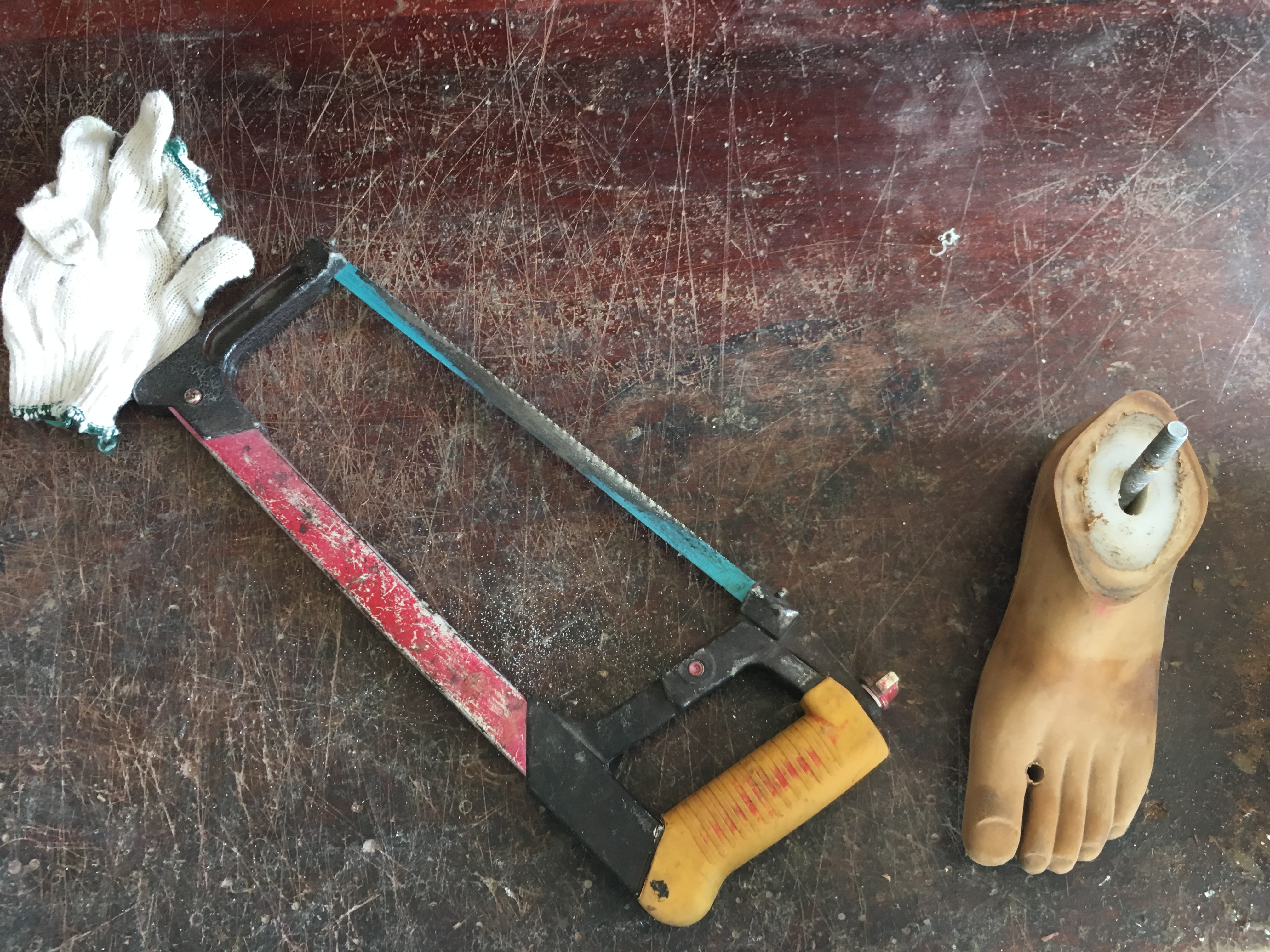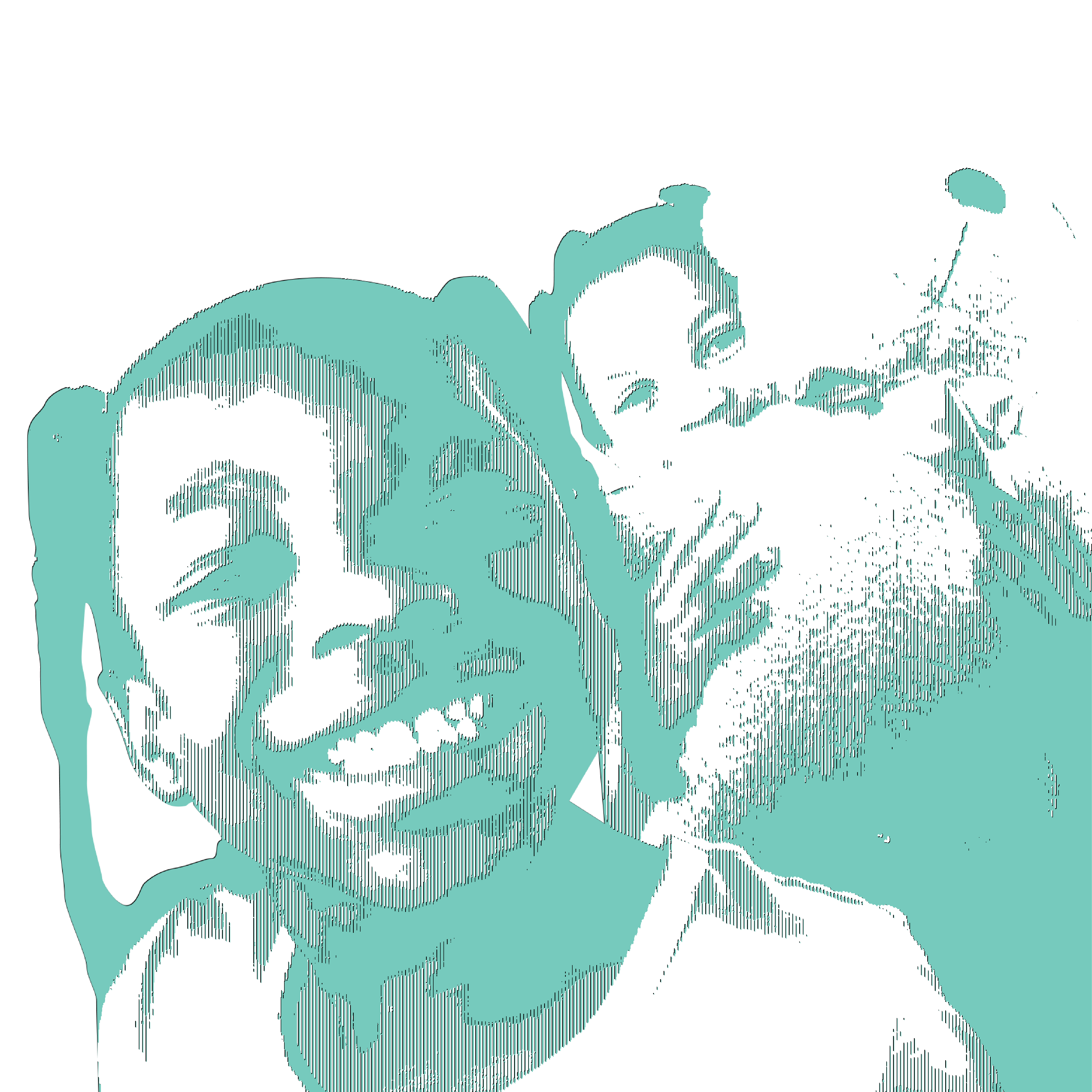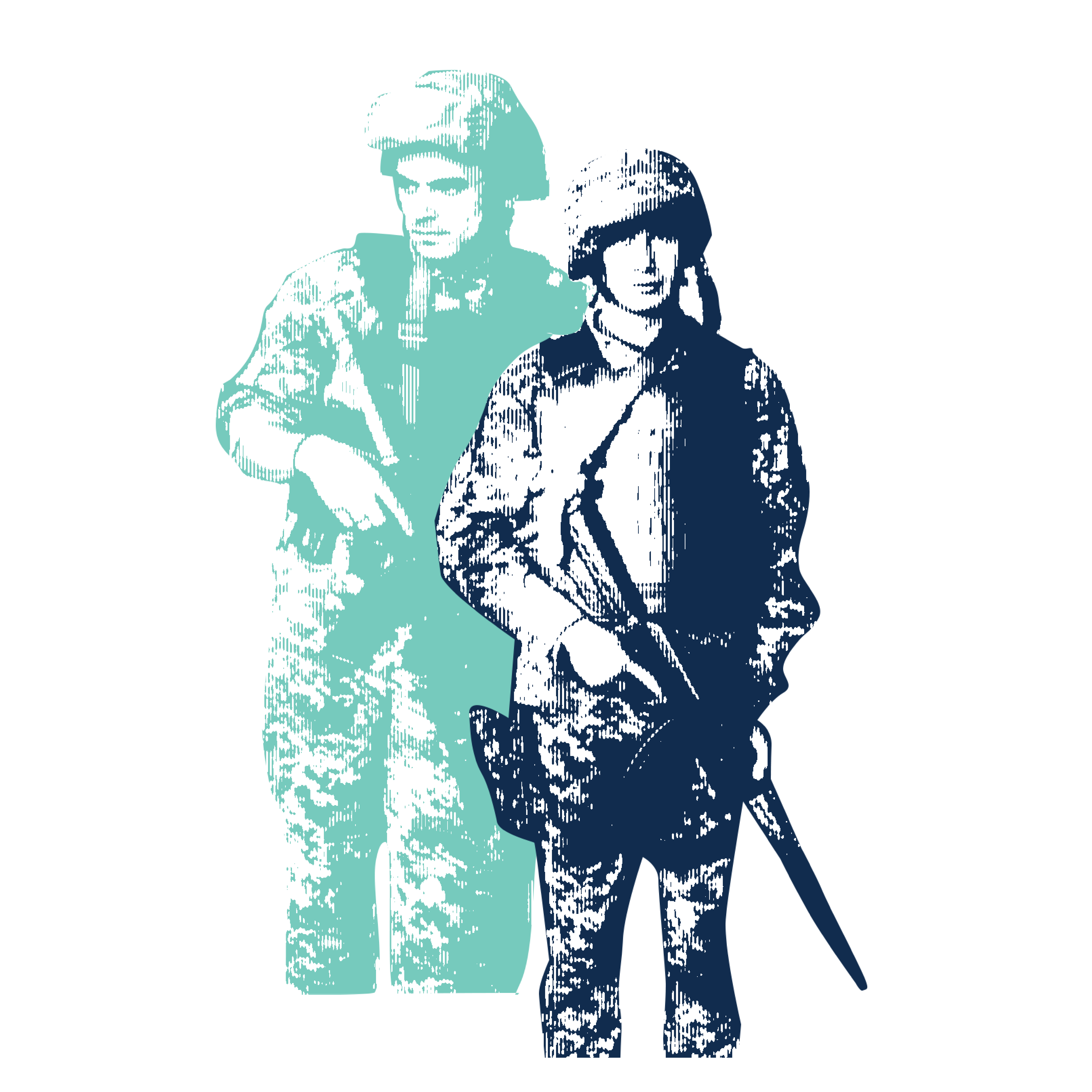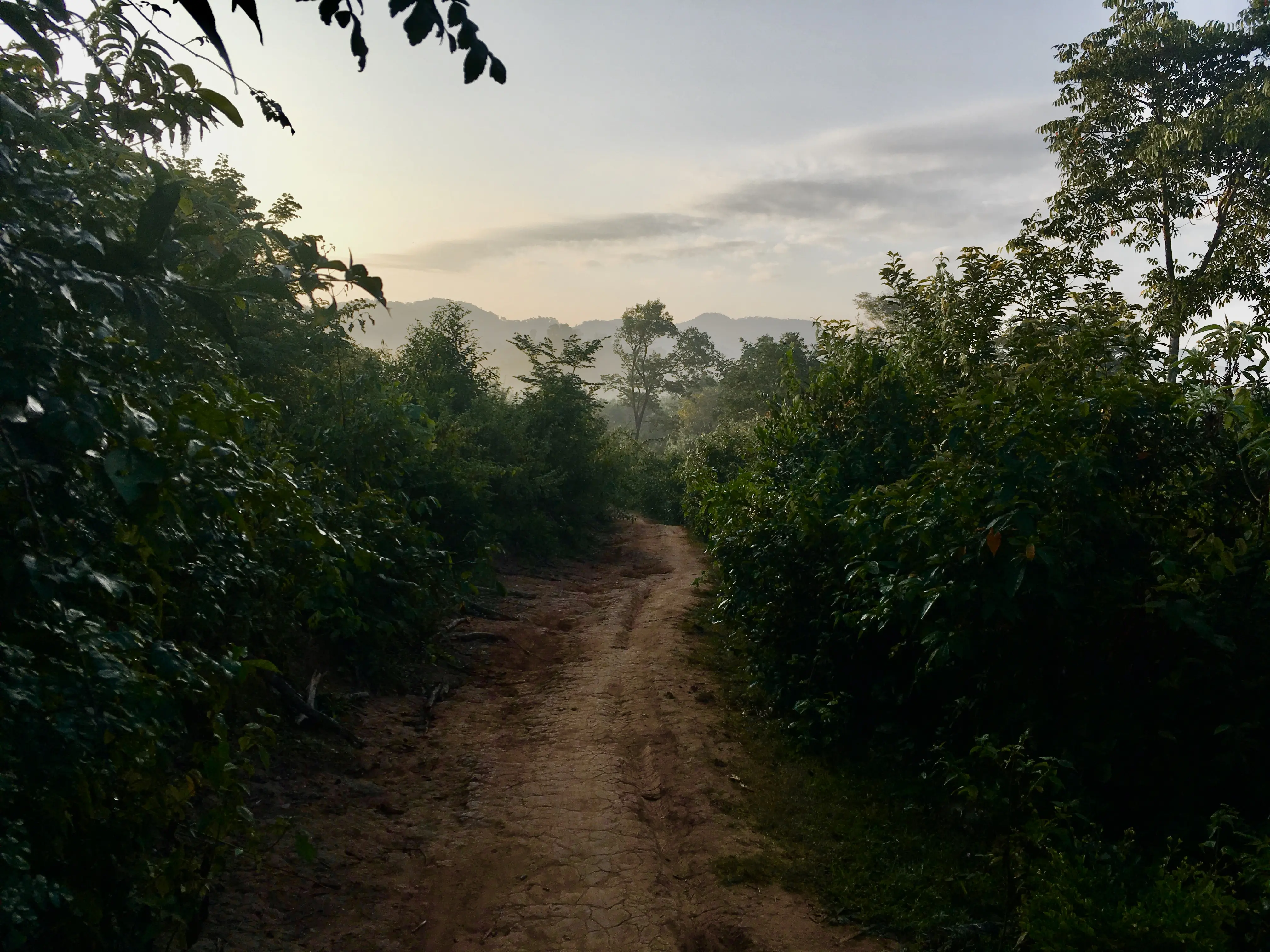
It was a blazing-hot morning in October 2019 on the old Ho Chi Minh Trail, an intricate web of truck roads and secret paths that wove its way across the densely forested and mountainous border between Vietnam and Laos. Susan Hammond, Jacquelyn Chagnon and Niphaphone Sengthong forded a rocky stream along the trail and came to a village of about 400 people called Labeng-Khok, once the site of a logistics base inside Laos used by the North Vietnamese Army to infiltrate troops into the South. In one of the bamboo-and-thatch stilt houses, the ladder to the living quarters was made from metal tubes that formerly held American cluster bombs. The family had a 4-year-old boy named Suk, who had difficulty sitting, standing and walking — one of three children in the extended family with birth defects. A cousin was born mute and did not learn to walk until he was 7. A third child, a girl, died at the age of 2. “That one could not sit up,” their great-uncle said. “The whole body was soft, as if there were no bones.” The women added Suk to the list of people with disabilities they have compiled on their intermittent treks through Laos’s sparsely populated border districts.
Hammond, Chagnon and Sengthong make up the core of the staff of a nongovernmental organization called the War Legacies Project. Hammond, a self-described Army brat whose father was a senior military officer in the war in Vietnam, founded the group in 2008. Chagnon, who is almost a generation older, was one of the first foreigners allowed to work in Laos after the conflict, representing a Quaker organization, the American Friends Service Committee. Sengthong, a retired schoolteacher who is Chagnon’s neighbor in the country’s capital, Vientiane, is responsible for the record-keeping and local coordination.
The main focus of the War Legacies Project is to document the long-term effects of the defoliant known as Agent Orange and provide humanitarian aid to its victims. Named for the colored stripe painted on its barrels, Agent Orange — best known for its widespread use by the U.S. military to clear vegetation during the Vietnam War — is notorious for being laced with a chemical contaminant called 2,3,7,8-Tetrachlorodibenzo-P-dioxin, or TCDD, regarded as one of the most toxic substances ever created.
The use of the herbicide in the neutral nation of Laos by the United States — secretly, illegally and in large amounts — remains one of the last untold stories of the American war in Southeast Asia. Decades later, even in official military records, the spraying of Laos is mentioned only in passing. When the Air Force in 1982 finally released its partially redacted official history of the defoliation campaign, Operation Ranch Hand, the three pages on Laos attracted almost no attention, other than a statement from Gen. William Westmoreland, a former commander of U.S. forces in Vietnam, that he knew nothing about it — although it was he who ordered it in the first place. Laos remained a forgotten footnote to a lost war. To those who followed the conflict’s aftermath intimately, this was hardly surprising. Only in the last two decades has the United States finally acknowledged and taken responsibility for the legacy of Agent Orange in Vietnam, committing hundreds of millions of dollars to aiding the victims and cleaning up the worst-contaminated hot spots there.
While records of spraying operations inside Laos exist, the extent to which the U.S. military broke international agreements has never been fully documented, until now. An in-depth, monthslong review of old Air Force records, including details of hundreds of spraying flights, as well as interviews with many residents of villages along the Ho Chi Minh Trail, reveals that, at a conservative estimate, at least 600,000 gallons of herbicides rained down on the ostensibly neutral nation during the war.
For years, Hammond and Chagnon were aware of the spraying in Laos, but the remote areas affected were almost inaccessible. Finally, in 2017, with new paved roads connecting the main towns, and many smaller villages accessible in the dry season by rough tracks, they were able to embark on systematic visits to the villages of the Bru, the Ta Oey, the Pa Co and the Co Tu, four of the ethnic minorities whose homes straddle the Laos-Vietnam border. It was the first time anyone had tried to assess the present-day impact of the defoliant on these groups.
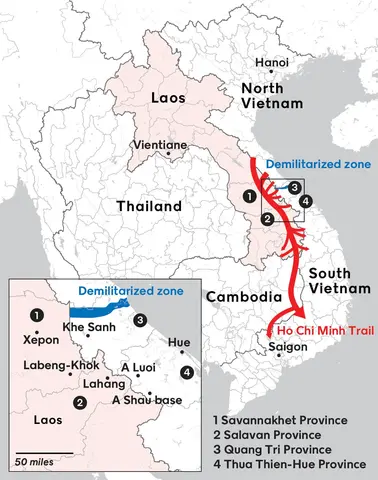
Of the 517 cases of disabilities and birth defects so far documented by the War Legacies Project in Laos, about three-fourths, like malformed limbs, are identifiable to the untrained eye as conditions of the sorts now linked to exposure to Agent Orange. “When we started the survey, I told American government officials we were doing it and said honestly that we didn’t know what we would find,” Hammond says. “In fact, I hoped we would find nothing. But as it turned out we’ve found a lot.”
Hammond’s requests for both the United States and Laos to acknowledge the long-term effects of the spraying have so far been met with bureaucratic rationalizations for inaction: Congress can do nothing without a clear signal from the Lao government; the Lao government has been hesitant to act without hard data; officials of the United States Agency for International Development in Vientiane have been sympathetic, but other senior embassy officials have waved away the problem. “One said that if we were so interested in what the U.S. had done in Laos, why didn’t we look at what the Soviets and the North Vietnamese had done?” Hammond recalls. “It was like being in a time warp, like dealing with an official in Vietnam in the 1990s. So we’ve been on this endless treadmill.”
So far, these conversations with officials have been informal, but this month she plans to submit the group’s findings to both governments, documenting the extent of the spraying recorded in the Air Force records and the number of disabilities the War Legacies Project has found. That’s when the governments of the United States and Laos will no longer have any reason to avoid taking action that is long overdue.
For Hammond and Chagnon, the personal connection to the war runs deep. Chagnon took time off from college in 1968 to work with Catholic Relief Services in Saigon, later living in a compound near the Tan Son Nhut air base. Even though public opinion had turned sharply against the war since the Tet offensive earlier that year, she wasn’t an antiwar activist. “I’d never been to a demonstration,” she says. “My parents were furious at me for going into a war zone.”
The first jolt to her innocence, she recalls, came when newspapers in Saigon published gruesome photographs of malformed babies and fetuses in Tay Ninh, a heavily sprayed province on the Cambodian border. By the late 1960s, Vietnamese doctors had strong indications that these congenital defects might be connected to the chemical defoliants. By the time Chagnon came home in 1970, the defoliation campaign was about to be shut down amid growing controversy over its possible health effects. But her anxiety increased. Many of the early spraying sorties had taken off from Tan Son Nhut, and she worried about her own exposure and the long-term effects if she had children. Those fears seemed to be confirmed when her daughter, Miranda, was born in 1985 with multiple birth defects. There was no proof that dioxin was responsible, and Miranda’s ailments were treatable with surgery and medication, but that hardly quelled Chagnon’s concerns about Agent Orange.
By this time Chagnon and her husband, Roger Rumpf, a theologian and well-known peace activist, were living in Vientiane and visited remote areas where few outsiders ever ventured. They had heard strange and unsettling stories in Xepon, a small town near the Vietnamese border. Doctors reported a rash of mysterious birth defects. A veterinarian told of farm animals born with extra limbs. There were anecdotal accounts of airplanes trailing a fine white spray. But it was impossible to find out more. “In those days there were no roads into the mountains,” Chagnon says. “You had to walk, sometimes for days.”
Hammond was born in 1965 while her father was serving at Fort Drum in upstate New York — a dark coincidence, she says, “since it was one of the first places they tested Agent Orange.” From there her father’s Army career took the family to Okinawa. Based in Danang, he was responsible for the construction of military installations in I Corps, the northernmost tactical zone in South Vietnam.
Hammond first went to Vietnam in 1991, when talk of normalizing relations was in the air. She fell in love with the place, abandoned thoughts of pursuing a Ph.D., moved to Ho Chi Minh City in 1996 to learn the language and spent the next decade organizing educational exchange programs and conferences to discuss Vietnam’s postwar humanitarian needs. It was at one of these events that she met Chagnon.
Since it began, their project has channeled modest amounts of material support to disabled people — things like a wheelchair ramp or a vocational training course or a brood cow to increase household income — in rural areas of Vietnam that were heavily sprayed. Then, in 2013, Chagnon’s husband died. “After Roger passed away, we started talking about the idea of doing a survey in Laos,” Hammond says. “I think Jacqui saw it as an opportunity to honor his memory.” After protracted negotiations with Lao authorities, the War Legacies Project signed a three-year memorandum of understanding, promising a full report by March 2021.
More than half the cases identified by the War Legacies Project are children age 16 and under. They are the grandchildren of those who were exposed during the war, and possibly even the great-grandchildren, since the people in these villages have traditionally married in their teens. Club feet are commonplace. So are cleft lips, sometimes accompanied by cleft palate. There are disturbing clusters: five babies born with missing eyes in Nong District; a family with five deaf-mute siblings; an inordinate number of short legs, malformed legs and hip dysplasia in Samuoi District — the latter a condition that is easily treatable in infancy, but if neglected will lead to severe pain, a waddling gait and more serious deformity. The rudimentary health care system in rural Laos means that few if any infants even get a diagnosis.
In each village the women visited, groups of elders assembled to share their stories, many in their 70s yet still with sharp memories. At first, they recounted, they had no idea who was spraying and bombing their villages, or why. But in time they learned the names of the airplanes: T-28, C-123, B-52. In most villages, dozens were killed by the bombings or died of starvation. The survivors lived for years in the forests or in caves. They dug earthen shelters, big enough to hide a whole family, and covered them with branches. “We had no rice for nine years,” one old man said. Sugar cane and lemongrass survived the spraying. So did cassava, though it swelled to an outlandish size and became inedible — Agent Orange accelerated the growth of plant tissue, killing most foliage.

For the most part, the old men told their stories dispassionately. But one Pa Co elder in Lahang, a place rife with birth defects, was bitter. He was an imposing 75-year-old named Kalod, tall, straight-backed, silver-haired, wearing a dark green suit with an epauletted shirt that gave him a military bearing. Like most of his people, Kalod saw the border as an artificial construct. During the war, people went back and forth between Laos and Vietnam, he said, depending on which side was being bombed and sprayed at the time. He leaned forward, gesticulating angrily. “Vietnamese people affected by the chemical spraying get compensation,” he complained. “In Laos, we need support from America, like they receive in Vietnam.”
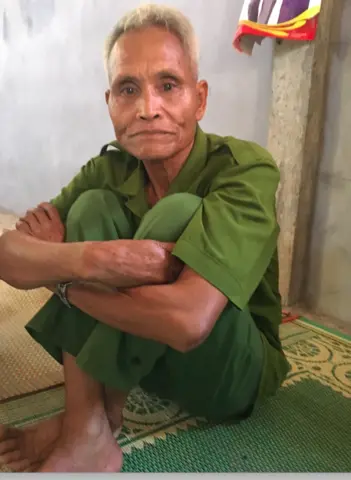
The 600,000 gallons of herbicides dropped in Laos is a fraction of the roughly 19 million that were sprayed on Vietnam, but the comparison is misleading. Between 1961 and 1971, some 18 percent of South Vietnam’s land area was targeted, about 12,000 square miles; in Laos the campaign, which began on the Ho Chi Minh Trail between Labeng-Khok and the Vietnamese border, was compressed in time and space. It was focused on narrow, defined strips of the trail, 500 meters wide (about 1,640 feet), and on nearby crop fields, and the heaviest spraying was concentrated in a four-month period early in the war. It was as intense a ramping-up of the defoliation campaign as in any major war zone in Vietnam at the time.
To make matters worse, the newly examined Air Force records show that the first intensive period of spraying in Laos used not Agent Orange, but the much more toxic Agent Purple, the use of which was discontinued in Vietnam almost a year earlier. Tests showed that the average concentration of TCDD in Agent Purple, a different chemical formulation, was as much as three times higher than in Agent Orange.
Long before the first Marines came ashore in Vietnam in 1965, infiltrators from the North were trickling into the South from the still-rudimentary Ho Chi Minh Trail, and the loyalties of the tribal groups along the border were dubious. In response to the growing insurgency, U.S. Special Forces set up small camps near the border with Laos, notably at Khe Sanh, which later became a gigantic Marine combat base, and in the A Shau valley, later infamous for the battle of Hamburger Hill and seen by U.S. strategists as the most important war zone in South Vietnam.
Operation Ranch Hand was in its infancy. By July 1962, only a handful of missions had been flown, defoliating the perimeters of highways, power lines, railroads and the waterways of the Mekong Delta. The commander of U.S. forces in Vietnam, Gen. Paul D. Harkins, now requested authority to hit six new targets. One of them was the A Shau valley, and it would be the first mission aimed at destroying crops that might feed the enemy. The Joint Chiefs of Staff refused: The location was too sensitive; the valley was right on the border, and the neutrality of Laos was just days from being guaranteed under an international agreement. Harkins pushed back, arguing that the proximity of the unsecured border was precisely the point. Despite President John F. Kennedy’s strong reservations about crop destruction, the mission went ahead.
The following January, a 25-year-old Army captain from the South Bronx arrived at the A Shau base. In February, “We burned down the thatched huts, starting the blaze with Ronson and Zippo cigarette lighters,” he wrote later. “The destruction became more sophisticated. Helicopters delivered 55-gallon drums of a chemical herbicide to us, a forerunner of Agent Orange. … Within minutes after we sprayed, the plants began to turn brown and wither.” The young officer was Colin Powell, future chairman of the Joint Chiefs of Staff and secretary of state. The chemical was Agent Purple. By the end of the defoliation campaign, at least half a million gallons of herbicides would be used in the A Shau valley, making it one of the most heavily sprayed places in Vietnam; thousands eventually became sick or died.
The flow of North Vietnamese troops down the trail only increased, and by late 1965 the C.I.A. was reporting that hundreds of miles of new roads had been built or upgraded to carry trucks. The Air Force was already bombing North Vietnam, so the obvious answer was to escalate the bombing on the Ho Chi Minh Trail in Laos.
But in addition to Laos’s neutrality, there was a second problem: Where exactly was the trail? It ran through some of the most remote and inhospitable terrain on Earth, concealed by dense rainforest, largely invisible to U-2 spy planes, infrared sensors on other aircraft, even low-flying helicopters. The solution was to strip away the forest cover to expose the bombing targets: the truck convoys and logistics centers like Labeng-Khok.
In essence, the initial spraying of Laos was a mapping exercise, formally integrated into a massive bombing campaign called Tiger Hound. In early December 1965, the ungainly C-123 aircraft, the workhorses of the herbicide campaign, crossed the Lao border for the first time. Within a week, the first wave of B-52s hit the Ho Chi Minh Trail.
The details of these air operations in Laos remained largely unknown until 1997, when Chagnon and Rumpf were at a get-together at the U.S. Embassy residences in Vientiane. They were friendly with Ambassador Wendy Chamberlin, who was on her way to Washington, Chagnon recalls. Was there anything they needed? Yes, Rumpf said, you can get the Air Force bombing records for Laos. While you’re at it, said Chagnon, never one to be shy, how about the records on Agent Orange?
By then, Chagnon and Hammond had gotten to know Thomas Boivin, a scientist with a Canadian company called Hatfield Consultants that was completing a landmark study of Agent Orange on the Vietnam side of the border, in the heavily sprayed A Shau valley (today known as the A Luoi valley, named after its main town). The records were in the form of computer punch cards and needed to be painstakingly converted into a database that showed every recorded flight, with its date and the geographical coordinates of where each spray run began and ended. Boivin later calculated that more than half a million gallons of chemicals had been sprayed on Laos, but other declassified Air Force documents show additional amounts not found in those initial records, and several village elders gave persuasive accounts of flights that didn’t seem to conform to the official data.
“I’m sure the records are incomplete,” says Jeanne Mager Stellman, an emerita professor of health policy and management at the Mailman School of Public Health at Columbia University, who played a pivotal role in documenting the spraying in Vietnam and calculating the risks of dioxin exposure for American veterans. “And my understanding is that the guys who were assigned to missions in Laos were sworn to secrecy.” Boivin adds that “the C.I.A. also undoubtedly used herbicides in Laos, but their records have never been declassified.”
In her push to have the U.S. government take responsibility for its actions in Laos, Hammond has been well aware that it took many years for the plight of America’s own veterans and their offspring to be acknowledged, and much longer still before the same compassion was extended to the Vietnamese victims of dioxin. The Agent Orange Act of 1991 was passed only after a bitter 14-year fight by veterans campaigning for recognition that the chronic illnesses that tens of thousands of them were developing might be directly connected to dioxin exposure. Once the legislation passed, it was determined that if you set foot in Vietnam between 1962 and 1975 and suffered from one of the conditions on the growing V.A. list, you were eligible for compensation. This resolution was a matter of political pragmatism rather than hard science. Although there was growing evidence of the toxicity of the herbicides, studies of their health impacts were inconclusive and fiercely contested. But the veterans formed an angry and influential constituency, and politicians had to assuage a good measure of guilt, both their own and that of the general public, over the trauma of those who had fought in a lost war that most Americans preferred to forget.
Accepting responsibility for the horrors visited on the Vietnamese took much longer. Even after diplomatic relations were restored in 1995, Agent Orange was a political third rail. Vietnamese complaints about the effects of the herbicides on human health — raising issues of reparations, corporate liability and possible war crimes — were dismissed as propaganda. American diplomats were forbidden even to utter the words. It was not until around 2000 that the United States was finally forced to acknowledge its obligations, after Hatfield Consultants completed its study of the impact of dioxin and showed U.S. officials incontrovertible evidence of how TCDD moved up the food chain, entered the human body and was transmitted to infants through breast milk.
Reconciliation between the United States and Vietnam was an intricate dance that depended on reciprocal steps to untangle the three most contentious legacies of the war. Once Washington had secured full cooperation in accounting for Americans missing in action, it began to aid Vietnam’s efforts to remove the vast amount of unexploded ordnance that still littered its fields and forests, killing and maiming tens of thousands. These steps, plus Hatfield’s breakthrough study, set the stage finally for the two countries to deal with Agent Orange, the most intractable problem of all.
The United States’ relationship with Laos has followed a similar sequence. Since the late 1980s, joint American-Lao teams have conducted hundreds of missions searching for the remains of aircrew who went missing on bombing missions, and over the last quarter-century Washington has committed more than $230 million to ordnance removal and related programs. The missing step has been Agent Orange, but lacking any data on its human impact, the Lao government has had little incentive to raise such a historically fraught issue. Few government soldiers fought in the sprayed areas, which were controlled by the North Vietnamese, so there were no veterans clamoring for recognition of their postwar sufferings. “In Vietnam, the magnitude of the problem made it impossible to ignore,” Hammond says. “But in Laos it was on a smaller scale, and in remote places outside of the political mainstream.”
All these years later, the mountainous border strip in the southern Lao panhandle is still a landscape defined by war and disease. Unexploded bombs are everywhere. The road that follows the Ho Chi Minh Trail south is a kind of living archive of the conflict, in which its remnants and relics have been absorbed into the fabric of everyday life. Men fish in boats made from the jettisoned fuel tanks of American fighter-bombers. Bomb craters from B-52 strikes are everywhere. Some are now fish ponds in the middle of the rice paddies.
Cluster-bomb casings have morphed into vegetable planters or substitute for wooden stilts to support the thatched huts that store rice, frustrating the claws of hungry rats. Everywhere the village soundtrack is the dull clang of cowbells made from sawed-off projectiles. “These are our gifts from the villagers of America,” one old man told me.

Once or twice the War Legacies team had to turn back, defeated by roads that were impassable after recent monsoon floods. Halfway to the village of Lapid, the four-wheel-drive vehicle ground to a halt in the hardened mud. Chagnon climbed out and paced up and down the steep slope, inspecting ruts that were deep enough to swallow a person whole. There was no way through. It was frustrating, because Lapid had been hit hard. An Operation Ranch Hand plane with its full load of chemicals had been shot down in the nearby hills, and after the war villagers called the area the “Leper Forest” for the high incidence of cancers and birth defects. On an earlier visit to Lapid, the War Legacies Project found a paralyzed baby girl, a 4-year-old with a club foot, a teenager born without eyes.
The survey has been a slow and laborious process. Since 2017, the women have visited scores of villages in heavily sprayed districts in two of the four border provinces that were targeted: Savannakhet and Salavan. In each village, they note the age and gender of each person affected, a description of their condition — with a firm diagnosis where possible — and a comment on any who might benefit from referral to a hospital in the provincial capital or in Vientiane. They exclude disabilities that are clearly unrelated to dioxin exposure, like the large number of limbs lost to cluster-munition bomblets. Their October 2019 trip was designed mainly to check up on cases they had already recorded, but they also found several new ones, like the boy in Labeng-Khok.
Hammond recognizes the limitations of their work. Some of their findings need to be verified by medical experts. “We’re not doctors or geneticists,” she says. Yet she, Chagnon and Sengthong are the first to try in Laos what has long been routine in Vietnam, where dioxin-related disabilities are logged systematically through commune-level surveys and household questionnaires and where victims receive small government stipends, and in some cases humanitarian aid from the United States.
It was Hatfield Consultants who unlocked the door to that aid, first through its four-year investigation of the A Luoi valley and then through subsequent studies of the former Danang air base. There had never been any secret about the huge volume of defoliants used in Vietnam, and the evidence of congenital disabilities in the sprayed areas was inescapable. Hatfield joined up the dots, showing how the two were connected and how dioxin could be transmitted from one generation to the next. But that was not Hatfield’s only insight. According to what it called the “hot spot” theory, the ongoing risk of present-day exposure was greatest around former military installations like the Special Forces base at A Shau, where the chemicals had been stored or spilled. Boivin wondered whether there might be similar dioxin hot spots on the Lao side of the border.
In 2002, Laos signed the Stockholm Convention on Persistent Organic Pollutants, a class of 12 “forever chemicals” including the dioxin family. All signatories were obligated to report on the extent of contamination in their countries. Boivin got a small grant from a U.N. agency to investigate dioxin in Laos, as the nation had little scientific expertise of its own. He found very little, but pursuing his hunch about Agent Orange, he made an arduous trip into the remote border areas, where it was strongly suspected that the C.I.A. had built secret airstrips, the kind of facilities that might have been used by herbicide planes and that would have been routinely sprayed to keep down vegetation, as they were in Vietnam.
Near a village called Dak Triem, he noticed a strikingly flat piece of land. Yes, the village elders said, it had once been an airstrip. Scavenging for scrap metal after the war, they found some barrels painted with orange stripes. Boivin had time to do no more than some perfunctory sampling, but he found elevated concentrations of TCDD, enough to classify the site as a possible hot spot and recommend further investigation. He and Hammond had known each other for years, and in 2014, with funding from Green Cross Switzerland and the European Space Agency, they collaborated on a more detailed report, which included a chronological table of all the known herbicide flights in Laos and a list of hundreds of clandestine C.I.A. facilities that might pose an ongoing health risk.
Boivin submitted his reports to the Lao government, but they gained little traction. This lack of interest might seem startling, but to veteran Laos watchers it comes as no surprise. “Things move slowly and cautiously there,” says Angela Dickey, a retired foreign-service officer who served as deputy chief of mission in Vientiane. “For an overworked midlevel official, there’s no real incentive to act on something like this. Only people at the very highest level can consider or speak about controversial issues.”
But there was a deeper reason for the lack of action on Boivin’s findings. He had made a preliminary estimate of the volume of defoliants used in Laos and found one contaminated air base. But he had never set out to collect data on the human impact. That was the missing piece of the puzzle that had been assembled in Vietnam, and that the War Legacies Project, using further Green Cross funding, set out to find.
When the United States finally agreed to clean up the Danang and Bien Hoa air bases in Vietnam, the two main hubs of Operation Ranch Hand, and aid the victims of Agent Orange in that country, it was an integral part of building trust between former enemies who increasingly see themselves as strategic allies and military partners. (Today, Bien Hoa is an important Vietnamese Air Force base.) In one of the larger oddities of history, the most painful legacy of the war has become a cornerstone of reconciliation.
In 2019, U.S.A.I.D. made a new five-year commitment to provide another $65 million in humanitarian aid to Vietnamese people with disabilities “in areas sprayed with Agent Orange and otherwise contaminated by dioxin.” The funds are channeled through the Leahy War Victims Fund, named for its creator, Senator Patrick Leahy, a Democrat from Hammond’s home state, Vermont, who for years has led the effort to help victims of Agent Orange in Vietnam. So why would the same logic not apply in Laos? “We weren’t aware of significant spraying in Laos,” Leahy said by email, “Nor of people with disabilities in those areas that are consistent with exposure to dioxin. But if that is what the data shows, then we need to look at it and discuss with the government of Laos what could be done to help those families.”
Hammond has met several times with Leahy’s longtime aide Tim Rieser, who seems eager to see what the War Legacies Project has found when it presents its report to his boss this month. “We have our work cut out for us in Vietnam,” he says, “but we’d also want to know what was done in Laos, since clearly those who were involved” — meaning wartime political and military leaders — “have not made a point of making it widely known. I’ve always approached this as doing what’s necessary to solve the problem, and if there’s more to the problem than we knew, then we need to deal with it.”
Hammond is painfully aware that bureaucratic wheels turn slowly; that Leahy, after 46 years in the Senate, may not be there much longer; and that Vietnam will always be the front-burner issue. In principle, the smaller scale of what’s needed should make it easier to address. “Even $3 million, which is what the U.S. started off with in Vietnam, would go a long way in Laos,” Hammond says. Meanwhile, the affected people are running out of time. Nine children under the age of 9 on the War Legacies Project list have already died.
U.S.A.I.D. already has an active disabilities program in Laos, which includes help for people injured by unexploded bombs. “All we need to do,” Hammond says, “is add the language we use now for Vietnam, earmark some money for ‘areas sprayed by Agent Orange and otherwise contaminated by dioxin.’ That one little sentence. That’s all it takes.”


